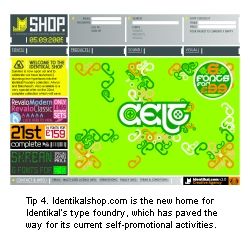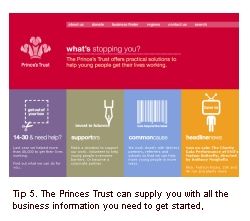Tips for freelancers
Two industry experts show you how to get yourself noticed in an ever-growing community of freelance creatives...
Stating up on your own, or promoting your business for the first time, is obviously a daunting task. Luckily, there are those who have been there before, come out the other side, and are able to advise you on what, and what not, to do. One such company is Identikal. Started by identical twins Adam and Nick Hayes in the late 90s, the company has achieved global recognition, due to hard work, self-belief and, of course, sublime talent.
Identikal offers invaluable advice for promoting your talent and getting your name out there.
Freelance essentials
1 Know your skills
Know your strengths and weaknesses. There are plenty of designers out there who still don't know their qualities and weaknesses as a designer. You should write down, in two separate columns, ten of each of your strengths and weaknesses. With your strengths you should concentrate on how to use them, and with your weaknesses you should aim to improve them as much as possible. Be honest with yourself!
2 Dream clients
Make a list of all of the brands or businesses you would only dream of working for. When Identikal started as a small business back in 1998 we had the likes of Sony PlayStation, Guinness, Orange and many other brand names in our first list. By the year 2000 we'd worked for them all, and still continue to do so.
3 Aim high
Aim for the sky. If you aim for the trees, you might hit the floor. We have always believed in this saying as it makes you understand the importance of having self-belief in what you can achieve as a freelance designer or small design business. Never believe that there's something you can't achieve.

4 Keep it simple
Never over-complicate your aims. By trying to achieve too much in a small amount of time you'll simply burn yourself out. Identikal became a name in design through our typefaces as we knew we had something which would get us noticed. This paved the way for us to show our other skills in illustration, multimedia, design and art direction once we'd built our reputation.
Get the Creative Bloq Newsletter
Daily design news, reviews, how-tos and more, as picked by the editors.
5 Be business minded
To be a successful freelancer, you need to be a successful businessman or woman. There are plenty of free start-up business courses out there which can teach successful business skills. Probably the most popular is the Princes Trust, which can offer you funding, in the form of a loan, to get you started.
6 Aspire to the masters
Learn from the best creatives out there. In the early days of Identikal, we always wanted to see what the best of the rest were up to and what kind of techniques they were using. All the great artists of the world have learnt their own techniques by being inspired by their masters or heroes - this includes Picasso, Warhol and even JMW Turner.
7 Learn from experience
Get plenty of work experience before you branch out into the lonely world of freelance design. While still at university we tried our best to gain as much experience as possible in the design world. This included going out on field trips to London and talking to the industry, as well as gaining work experiences with them before we left university and created Identikal.
8 Read design mags
Keep ahead of the game by buying the regular design press magazines. It's important that you keep an eye on what route the industry is taking. This doesn't necessarily mean you need to copy the new styles, but it allows you to see what your competitors are up too.
9 Believe in yourself
Confidence breeds success, so make sure you believe in what you're doing. If your heart isn't in it then you shouldn't be in the business. There are thousands of young freelancers who quit in their first year of going it alone. This is simply because they aren't confident in what they want to achieve.
10 Draw up a business plan
Write a mission statement and a business plan about what your business is all about. This will become your bible wherever you choose to go in the world of design, so keep it close to you, and always update it to suit the position of your business.
Finding clients
11 Build a contacts directory
By using the list that you have created from Tip 2, you should research every form of contact you can about each company: email, website, fax, and so on. By doing so, you will create a directory of possible clients that you can contact in any form of communication and at any point in the world. We remember being in Chicago and arranging a meeting with Nike in London because of the Identikal Directory. It really does become a fantastic tool for communication.
12 Make direct contact
Contact each individual business and get hold of direct line numbers of the correct people. It's no good having the names of a thousand secretaries of the companies on your list. What you really need is the direct line numbers, emails and mobile numbers of the people that

will be willing to see your work.
13 Meet face to face
Always arrange a portfolio viewing as the first point of contact. The phone is an important means of communication, but it's only useful for an introduction. There is nothing better than seeing your possible client face to face, so you can show them what you're all about and what use you can be to them.
14 Be sparing with freebies
Give away your freebies to the correct people. There's no point in having 1,000 cool stickers as a means of promotion and then you give them away to friends and people in the street. These forms of self-promotion really need to be used sparingly and wisely. This means they should only be given to your potential clients. You'll be surprised how quickly these things run out!
15 Take on some smaller clients
Try to get a range of clients to work for. You don't need to aim high all the time, and the local hairdressers, bar or clothes shop is always crying out for a flyer or advert to promote their business. These kind of clients can provide you your bread-and-butter work.
16 Exchange services
Be willing to provide your services in exchange for another service. Throughout the years that Identikal has been around, in some cases we have provided design services in return for services from another company. Recently, we designed a corporate identity for a media company, who in turn provided us with important media solutions. You are in a creative community, so use it to its full advantages.
17 Get your work published
Try to get your work into the hip magazines. This may mean that you won't get paid, but it does mean that the right audience will see your work. Back in 1998 Identikal produced regular work for the urban magazine Lowdown. As a result of this magazine coverage, we had an interview on MTV and got plenty of illustration and typography work from the publishing industry.
18 Ditch the CV
Never send out your CV to potential clients. You are in a creative business and the last thing they want to see is if you worked in McDonalds while at University, or if you got a Trident gold certificate. There will be hundreds of CVs floating about in their inbox and they'll probably all be binned without being looked at.
19 Know how to invoice
As mentioned in Tip 5 on the previous pages, you really need to have the correct business skills to make a success of being a freelance designer. The Inland Revenue provides a free course as well as booklets in how to do this correctly. Sign up to this through your local business link centre.
20 Set up a business account
Get the right business account before receiving your first cheque. A client will be suspicious of your business if he/she is writing out a cheque to Mr/Mrs Smith. They should be writing it out to your business name. There are plenty of great offers for first-timers from all the major banks, so shop around until you find the best deal.

Thank you for reading 5 articles this month* Join now for unlimited access
Enjoy your first month for just £1 / $1 / €1
*Read 5 free articles per month without a subscription

Join now for unlimited access
Try first month for just £1 / $1 / €1
The Creative Bloq team is made up of a group of design fans, and has changed and evolved since Creative Bloq began back in 2012. The current website team consists of eight full-time members of staff: Editor Georgia Coggan, Deputy Editor Rosie Hilder, Ecommerce Editor Beren Neale, Senior News Editor Daniel Piper, Editor, Digital Art and 3D Ian Dean, Tech Reviews Editor Erlingur Einarsson, Ecommerce Writer Beth Nicholls and Staff Writer Natalie Fear, as well as a roster of freelancers from around the world. The ImagineFX magazine team also pitch in, ensuring that content from leading digital art publication ImagineFX is represented on Creative Bloq.
